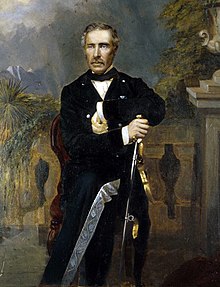George Edward Gray
Sir George Edward Gray KCB , also called He Mea Kohikohi Mai by the Māori , (born April 14, 1812 in Lisbon , † September 19, 1898 in London ) was a soldier, explorer, writer and governor of South Australia , New Zealand and the Cape Colony ( South Africa). From 1877 to 1879 he was Prime Minister of New Zealand .
Life
Gray was born in 1812 a few days after his father's death at the Battle of Badajoz .
As a young man in 1837 he led a poorly prepared expedition to explore northwest Australia. The exhausted, inexperienced members of the expedition nearly drowned, and Gray was injured in an argument with Aborigines . The group had to give up. A second expedition in 1839 also ran into great difficulties. The participants could only survive with the help of a Noongar , which provided them with food and water. Gray was one of the few Europeans to learn the Noongar language.
From 1841 to 1845 he was Governor of South Australia. He was particularly distinguished by his financial policy, which allowed the colony to survive difficult early times.
He left Australia to become Governor of New Zealand from 1845 to 1853 and again from 1861 to 1868 . He had a major influence on the New Zealand Constitution of 1852, which first allowed the country to self-govern, and was instrumental in the formation of provinces in New Zealand. He put down Māori riots on the North Island, but on the other hand he ensured that the agreements made with the Māori, in particular the Treaty of Waitangi , were respected and that land grabbing did not take place. His efforts to assimilate the Māori remain largely unsuccessful due to a lack of sufficient financial means.
In his second term in office in the 1860s, Gray learned the Māori language and had them put their legends and traditions into writing. In 1862 he bought Kawau Island , which he set up as a private refuge. The following year he organized the Waikato War , which resulted in the British taking possession of the fertile farmland in the Waikato region and bringing many British soldiers to the islands. In 1875 he was appointed superintendent of the Auckland Province and entered parliament. He was Prime Minister between 1877 and 1879.
Between his two terms in New Zealand, he was governor of the Cape Colony from 1854 to 1861 , where he founded the schools named after him Gray College ( Bloemfontein ) and Gray High School ( Port Elizabeth ). Vusamazulu Credo Mutwa , an African historian, accuses Gray of having helped found apartheid in the mid-19th century .
legacy
The following geographical objects are or were named after Gray:
- Greytown (New Zealand)
- Gray River (Tasman Sea)
- Greymouth (New Zealand)
- Greytown (South Africa)
- Glen Gray District , a former administrative division in the former Cape Colony
Works
- Polynesian Mythology and Ancient Traditional History of the New Zealand Race. H. Brett, Auckland 1885. ( digitized version ).
literature
- James Collier: Sir George Gray. Governor, High Commissioner, and Premier. An historical biography. [With a portrait.] Whitcombe & Tombs: Christchurch, NZ, 1909
Web links
- Keith Sinclair: Gray, George. In: Te Ara - the Encyclopedia of New Zealand. teara.govt.nz, accessed on November 28, 2017 (English).
- Biography on primeminister.govt.nz (English)
- Expedition reports on gutenberg.org (English)
| predecessor | Office | successor |
|---|---|---|
| Robert FitzRoy |
Governor of New Zealand 1846–1853 |
Thomas Gore Browne |
| Thomas Gore Browne |
Governor of New Zealand 1861–1868 |
George Ferguson Bowen |
| personal data | |
|---|---|
| SURNAME | Gray, George Edward |
| BRIEF DESCRIPTION | New Zealand politician, Prime Minister of New Zealand (1877–1879), Governor of the Cape Colony, South Australia and New Zealand |
| DATE OF BIRTH | April 14, 1812 |
| PLACE OF BIRTH | Lisbon , Portugal |
| DATE OF DEATH | September 19, 1898 |
| Place of death | London , UK |
